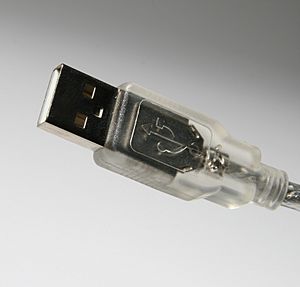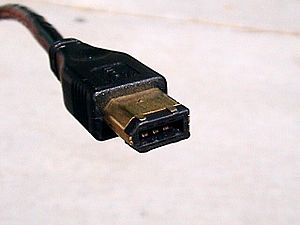Plug and play facts for kids
Plug and play is a cool feature in computers. It lets you connect new devices, like a USB stick or a printer, to your computer. The best part? You can usually start using them right away! You don't need to do much setup. When you're done, you can just unplug them.
This technology makes it super easy to add new gadgets. You don't have to install special software called "drivers" yourself. The computer often finds and sets up the device for you.
Contents
What is Plug and Play?
Plug and play means that your computer can automatically find and set up new hardware. Imagine plugging in a new mouse. With plug and play, your computer recognizes it. It then gets it ready to use without you having to do anything extra. This saves you time and makes using computers much simpler.
How Does it Work?
When you connect a new device, your computer talks to it. The device tells the computer what it is and what it needs. The computer then finds the right "driver" software. A driver is like a small instruction manual for the computer. It tells the computer how to communicate with that specific device.
Once the driver is loaded, the device is ready to go. This whole process happens very quickly in the background.
History of Plug and Play
In the past, connecting new devices was much harder. You often had to manually install drivers. Sometimes, you even had to change settings inside the computer. This was tricky and could cause problems if done wrong.
In the 1990s, companies like Microsoft and Intel worked to make things easier. They developed the first true plug and play systems. This made computers much more user-friendly for everyone.
Examples of Plug and Play Devices
Many modern connections use plug and play. Here are some common examples:
- USB (Universal Serial Bus): This is probably the most common type. Think of USB drives, keyboards, mice, and webcams. You just plug them into a USB port, and they usually work instantly.
- Firewire (IEEE 1394): This is another type of connection, often used for video cameras and external hard drives. Like USB, it's designed for easy plug and play.
- Bluetooth: Wireless devices like headphones and speakers often use Bluetooth. Once paired, they connect automatically.
- HDMI: Used for connecting monitors and TVs. When you plug in an HDMI cable, your computer or TV usually recognizes the display right away.
Benefits of Plug and Play
Plug and play offers many advantages:
- Easy to Use: It makes adding new hardware simple for everyone, even if you're not a computer expert.
- Saves Time: You don't waste time searching for and installing drivers.
- Less Frustration: It reduces the chances of errors or conflicts when setting up new devices.
- Hot Swapping: Many plug and play devices can be connected or disconnected while the computer is still on. This is called "hot swapping."
Images for kids
See also
 In Spanish: Plug and play para niños
In Spanish: Plug and play para niños






